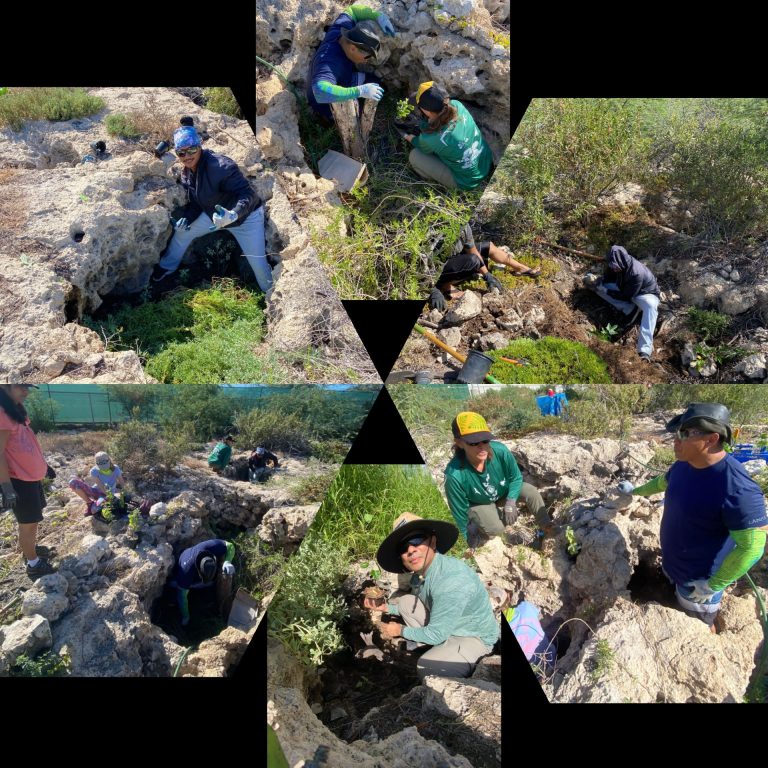Kapu - KĀLUA'ŌLOHE
Kānāwai: Ka 'ike pāpālua [with lua meaning pit, duality, and the martial art of Hawai'i]
The sinkhole landscape holds much cultural significance as a resource in tandem with traditional knowledge to create a thriving home. Without this traditional knowledge, it is easy to view the unique pa’akea surroundings as a hostile wasteland. However, the community here in ancient times understood the wealth of the environment and actualized that goodness. Nā kālua represent the duality of knowledge, encompassing ideas such as double knowledge and second sight. It is manifested in knowing what is not seen and seeing more than what appears on the surface. Today the protected landscape of Kīpuka O Kahinahina is a crucial habitat for the ʻewahinahina, a little known endangered endemic plant once found throughout west O’ahu.
Kapu - KĀLUAWAI
Kānāwai: 'A'ohe lolena i ka wai 'ōpae
Kāluawai refers to the sinkholes that give access to the subterranean waters which come down from above. In traditional times, this kālua provided a necessary water resource for those who lived in the arid conditions of west Honouliuli. Besides providing clean water to drink, some kāluawai were utilized for bathing. Up until very recent times, the pristine water quality of the kāluawai in this area was evident by the abundant presence of the ‘ōpae’ula, or native Hawaiian shrimp. This kānāwai with its kapu encourages us not to neglect to be vigilant and caring for our kālua landscape lest it becomes unlivable. We are to spur into action by opening and restoring nā kālua; allowing the ʻāina to breathe again while monitoring the waters below.

Kapu: KĀLUAMAHI
Kānāwai: Nā 'ulu hua i ka hāpapa (Pukui 1983)
Kāluamahi refers to the sinkholes that were once utilized for agricultural purposes in the Kalaeloa area. Our Hawaiian ancestors cultivated various crops in the kāluamahi, such as, kī, noni, kō, and kukui while also planting ʻuala on the grounds around them. This was complemented by the natural vegetation of the area found in ‘ākulikuli, wiliwili, naio, nohu, kauna’oa, the endangered ‘ewahinahina, and other native plants. We are inspired by the ʻōlelo noʻeau which references the fruitful ʻulu trees of Niʻihau thriving in their sinkhole environment. The tops of the trees would spread across the ground, bountiful with fruit while below the ground grew strong healthy tree trunks. Nā kāluamahi encourage us to aim for self-sufficiency, using the natural features of this landscape to grow plants for food, medicine, and other necessities of life.
KAHEA O KALAELOA
Uliuli ke kula o Kāne.
He kula nui ma ka peʻa,
Peʻe ka peʻelua, ka peʻepeʻemakawalu.
Ka mea ewa hili hewa i ka wiliwili,
Hilia i ka ua kona hina mai ke kai.
‘Auhea e ka hale o Kamaunuaniho,
Ma waho au,
I ka ua, ka ‘ino, ke anu, ke
koʻekoʻe, ‘Imi i ke aloha o loko.
‘Ike ‘ia nō ka lokomaika’i.
Dark are the plains of Kāne
The great plains at the boundary
Hiding are the caterpillars, the spiders
The wandering one entangled in the wiliwili
Hit hard by the rain coming in from the sea
Lend an ear, where are you, oh house of Kamaunuaniho?
I am outside
Where it is rainy, stormy, cold and chilling
Looking for the love that is inside
The goodness from within is known by me
As explained in the paper, Urban ‘Āina, the word kapu is used “to express the things we hold sacred, the resources or elements we literally cannot live without” (Deluze et al., 2023) and the word kānāwai translates to “actions to maintain resources” (Department of Hawaiian Home Lands, 2023). The three kapu emphasized in Kīpuka o Kahinahina are kāluaʻōlohe, kāluawai, and kāluamahi.

